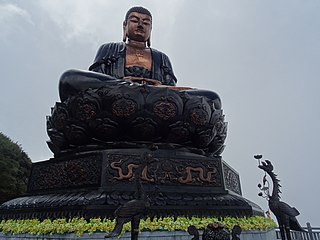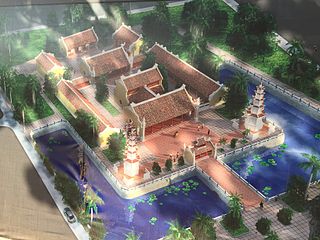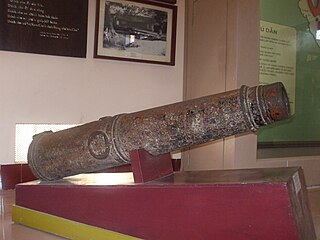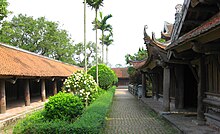Articles related to Vietnam and Vietnamese culture include:

The Lý dynasty, officially Đại Cồ Việt from 1009 to 1054 and Đại Việt from 1054 to 1225, was a Vietnamese dynasty that existed from 1009 to 1225. It was established by Lý Công Uẩn when he overthrew the Early Lê dynasty. The dynasty ended when empress regnant Lý Chiêu Hoàng was pressured to abdicate the throne in favor of her husband, Trần Cảnh in 1225, the dynasty lasts for 216 years. During Lý Thánh Tông's reign, the official name of the state was changed from Đại Cồ Việt to Đại Việt, a name that would remain Vietnam's official name until the onset of the 19th century.

Buddhism in Vietnam, as practiced by the Vietnamese people, is a form of East Asian Mahayana Buddhism. It is the main religion in Vietnam. Vietnamese Buddhism is generally inclusive and syncretic, drawing on the main Chinese Buddhist traditions, such as Tiantai and Huayan, Zen (Thiền), and Pure Land.

The Trần dynasty,, officially Đại Việt, was a Vietnamese dynasty that ruled from 1225 to 1400. The dynasty was founded when emperor Trần Thái Tông ascended to the throne after his uncle Trần Thủ Độ orchestrated the overthrow of the Lý dynasty. The Trần dynasty defeated three Mongol invasions, most notably during the decisive Battle of Bạch Đằng River in 1288. The final emperor of the dynasty was Thiếu Đế, who was forced to abdicate the throne in 1400, at the age of five years old in favor of his maternal grandfather, Hồ Quý Ly.

Lý Nhân Tông, personal name Lý Càn Đức, temple name Nhân Tông was the fourth emperor of the Lý dynasty, ruling the kingdom of Đại Việt from 1072 until his death in 1128. Succeeding his father Lý Thánh Tông at the age of 7, during his early reign Lý Nhân Tông ruled with the assistance of his mother Ỷ Lan and the chancellor Lý Đạo Thành who were both considered competent regents and were able to help the emperor maintain the country's prosperity. Appreciated as a great emperor of the Lý dynasty, Lý Nhân Tông made important contributions to the development of Đại Việt, especially for establishing Confucianism as the official philosophy of the state, creating Confucian-based imperial exams, and creating schools based on the Confucian system of learning. During his 55-year reign, which was the longest reign for any Vietnamese monarch, Lý Nhân Tông also experienced several wars against Đại Việt's neighbours, the Song dynasty and the kingdom of Champa in which the Sino–Vietnamese War (1075–1076) was the fiercest. After his death, the royal family lost their control over the court to the chancellors and the bureaucracies.

Emperor Quang Trung or Nguyễn Huệ, also known as Nguyễn Quang Bình, or Hồ Thơm was the second emperor of the Tây Sơn dynasty, reigning from 1788 until 1792. He was also one of the most successful military commanders in Vietnam's history. Nguyễn Huệ and his brothers, Nguyễn Nhạc and Nguyễn Lữ, together known as the Tây Sơn brothers, were the leaders of the Tây Sơn rebellion. As rebels, they conquered Vietnam, overthrowing the imperial Later Lê dynasty and the two rival feudal houses of the Nguyễn in the south and the Trịnh in the north.
Trần Thái Tông, personal name Trần Cảnh or Trần Nhật Cảnh, temple name Thái Tông, was the first emperor of the Trần dynasty, reigned Đại Việt for 33 years (1226–58), being Retired Emperor for 19 years. He reigned during the first Mongol invasion of Vietnam before eventually abdicating in favor of his son Trần Hoảng in 1258.
Vụ Bản is a rural district of Nam Định province in the Red River Delta region of Vietnam.

The One Pillar Pagoda, formally belongs to an architecture complex called Diên Hựu tự which means 'pagoda of extended blessings'. The pagoda is a historic Buddhist temple in the central Ba Đình district, Hanoi, the capital of Vietnam. The most famous part of this architecture complex is Liên Hoa Đài (蓮花臺) means 'the lotus pedestal' which is a temple with special structure: a building laid on one pillar. The original pagoda was built in 1049, had some additions and was perfected in 1105. It is regarded alongside the Hương Temple, as one of Vietnam's two most iconic temples.
Prince Trung Võ Trần Thủ Độ was a general and leader of the Trần clan during the reign of Lý Huệ Tông and Lý Chiêu Hoàng of Vietnam. He was the chief mastermind between the overthrowal the Lý dynasty and the establishment of the Trần dynasty by his arrangement of marriage between the Empress Regnant Chiêu Hoàng and his nephew Trần Cảnh. He later forced Lý Chiêu Hoàng to abdicate the throne to Trần Cảnh, who became emperor as Trần Thái Tông. Trần Thủ Độ was appointed grand chancellor and regent to the emperor.
Prince Tĩnh Quốc Trần Quốc Khang (1237–1300) was the first prince of the Emperor Trần Thái Tông, the eldest brother of Trần Thánh Tông and princes Trần Quang Khải, Trần Ích Tắc and Trần Nhật Duật. Although a son of Thái Tông in name, Trần Quốc Khang's father was actually Prince Hoài Trần Liễu, who was forced by grand chancellor Trần Thủ Độ to give up his wife, Princess Thuận Thiên, to his younger brother Thái Tông when she was already pregnant with Trần Quốc Khang. For this reason, Trần Quốc Khang was not chosen as successor of Thái Tông for the throne, and he did not have a significant role in royal court either, as his younger brothers did. Afterwards he was appointed as governor of Nghệ An, a position that his descendants inherited. Since Trần Quốc Khang was in fact a son of Trần Liễu, he was also a natural brother of general Trần Hưng Đạo, commander-in-chief of Đại Việt army.
Empress Thuận Thiên (1216–1248) was the second empress of Trần dynasty, she succeeded her younger sister Empress Chiêu Thánh in 1237 by an arrangement of Trần Thủ Độ in which Prince Hoài Trần Liễu was forced to give up his 3-month pregnant wife Princess Thuận Thiên to the Emperor Trần Thái Tông. Thuận Thiên was born in the royal family of the Lý dynasty as the first child of the Emperor Lý Huệ Tông and Lady Thuận Trinh Trần Thị Dung with whom she witnessed the turbulent time of the Late Lý and Early Trần Dynasty. She was mother of four princes including the second emperor of the Trần Dynasty Trần Thánh Tông and grand chancellor Prince Chiêu Minh Trần Quang Khải.
Emperor Lý Anh Tông of Đại Việt was the sixth emperor of the later Lý dynasty, from 1138 until his death in 1175. Since Lý Anh Tông, given name Lý Thiên Tộ, was chosen as the successor of his father Lý Thần Tông at the age of only two, the early period of his reign witnessed the dominant position of Đỗ Anh Vũ in the royal court until he died in 1157, afterwards the Emperor ruled the country with the assistance of a prominent official named Tô Hiến Thành. The reign of Lý Anh Tông was considered the last relatively stable period of the Lý dynasty before the turbulence during the reign of Lý Cao Tông.
Lý Thần Tông (1116–1138), personal name Lý Dương Hoán, was the fifth emperor of the Lý dynasty, reigning over Đại Việt from 1127 to his death in 1138. Becoming the ruler of Đại Việt at the age of twelve, Lý Thần Tông successfully maintained the order of the royal court and strengthened the stability of the country with the assistance of capable officials. For that reason, Đại Việt under Lý Thần Tông was able to witness a peaceful period like during the reign of his predecessors. However, Lý Thần Tông died at age 22 before passing the throne to his crown prince Lý Thiên Tộ.

Lê Văn Thịnh, courtesy name Mậu Phu (茂夫), was an official in the royal court of the Lý dynasty. Ranking first in the first imperial examination of the Lý dynasty, Lê Văn Thịnh was appointed tutor for Lý Nhân Tông and was gradually promoted to the position of chancellor of the Lý dynasty due to his achievements, especially in the negotiation with the Song dynasty about the return of occupied land by the Song army to Annam in 1086.

Ỷ Lan or Empress MotherLinh Nhân was a Vietnamese concubine and regent who effectively controlled the imperial government of Vietnam for over 40 years.

Hoằng Phúc Temple is a temple located in Thuan Trach Village, Mỹ Thủy Commune, Lệ Thủy District, Quảng Bình Province, North Central Coast Region of Vietnam. The temple has a history of more than 700 years, one of the oldest temples in Central Vietnam.
Lý Thị Ngọc Kiều, dharma name Diệu Nhân (妙因), was a princess during the Lý dynasty in Vietnamese history. She was the 17th leader of the Vietnamese Vinītaruci school of Buddhism.

The Tây Sơn rebel army incorporated during the three decades of its existence new and unconventional ideas of tactics and organization. Logistic and tactical aspects like intelligence analysis, troop co-operation, transport and movement were radically revised, imposed and coupled with deception, diplomacy and guerilla tactics, that eventually proved remarkably efficient. Conceived and applied by military leader Nguyen Hue under whom the Tây Sơn forces engaged into a series of combat operations and skillfully defeated experienced and trained, regular troops, of Cambodia, Siam, Laos, the Chinese Qing empire and the domestic feudal armies of the Trịnh Lords, Nguyễn Lords and the imperial Lê dynasty. Some of the Tây Sơn victories rank among the greatest achievements in Vietnamese military history.

The government of the Nguyễn dynasty, officially the Southern dynasty and commonly referred to as the Huế Court, centred around the emperor as the absolute monarch, surrounded by various imperial agencies and ministries which stayed under the emperor's presidency. Following the signing of the Patenôtre Treaty the French took over a lot of control and while the government of the Nguyễn dynasty still nominally ruled the French protectorates of Annam and Tonkin, in reality the French maintained control over these territories and the Nguyễn government became subsidiary to the administration of French Indochina. During World War II the Japanese launched a coup d'état ousting the French and establishing the Empire of Vietnam which was ruled by the Nguyễn government. During the August Revolution the Nguyễn government was abolished in the aftermath of World War II.












